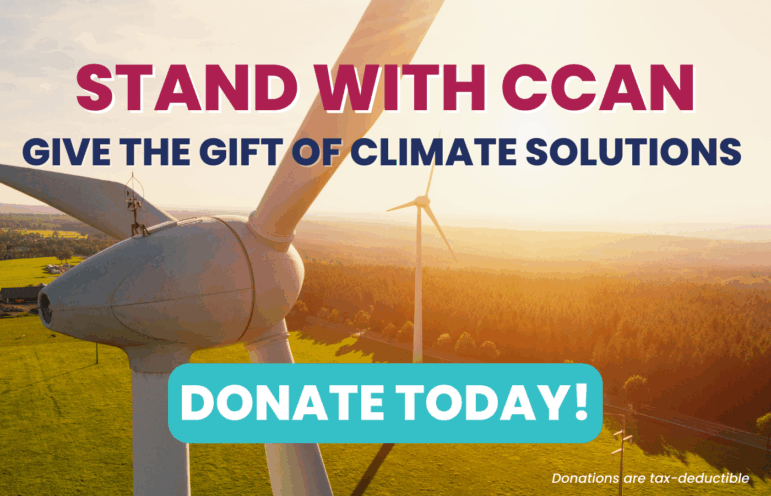Writings
{tab=Books}
{module Books}
{tab=Essays}
{module Essays}
{tab=Letters from the Director}
{module Letters from the Director}
{/tabs}
Connect
{module Connect}
Friends of CCAN
It’s CCAN’s 10th Birthday and all of our supporters are wishing a good tenth. We look forward to growing our network of supporters, friends and fans in the coming decade.
Stuart Clarke, Executive Director, Town Creek Foundation
Stuart Clarke and his friends at Town Creek Foundation went above and beyond in wishing CCAN a happy birthday! Watch the video to see their special gift.
Bill McKibben, Author, 350.org founder
Bill McKibben, prolific author and founder of international climate change advocacy group 350.org, has called CCAN “the world’s best regional climate change group.” See what he has to say on the occasion of CCAN’s 10th birthday.
Greenpeace Executive Director Phil Radford
Phil Radford sends CCAN his best wishes in our 10th year.
Congresswoman Donna Edwards
Congresswoman Donna Edwards from Maryland wishes CCAN happy 10 years. Hope to see you at next year’s Polar Bear Plunge, Congresswoman!
Reverend Lennox Yearwood of Hip Hop Caucus
The founder, President and CEO of the Hip Hop Caucus encourages CCAN to keep fighting the good fight!
Father Jacek Orzechowski, St. Camillus
Father Jacek wishes CCAN even more success in the next 10 years!
Maryland State Senator Paul Pinsky
Environmental champion Sen. Paul Pinsky congratulates CCAN on 10 years.
Lori Hill, Volunteer & owner of lori hill event productions
Superstar CCAN volunteer and event planner Lori Hill wishes CCAN happy 10 years.
MOM’s Organic Market owner, Scott Nash
Local green business owner and CCAN supporter, Scott Nash, wishes CCAN a happy birthday.
Upcoming Coal Event at Towson University
Event information was sent from Baltimore student Thalia Patrinos
Towson is having a activism panel and screening event all about the issues surrounding coal!
On Thursday, September 15th, 6:00 – 7:30 We will have panel discussions featuring Climate Ground Zero’s Mike Rosell and Antrim Caskey, two key figures in the social movement against Massey Energy. Then from 7:30 – 9 we will have a Community Resource Fair, featuring several organizations committed to working with labor movements.
On Friday, September 16th starting at 4 will be a large teach-in on Freedom Square.
There will also be a film shot, edited and produced by Towson University student David Resiche as well as a photo exhibition by Antonio Hernandez, both exploring the struggles of local communities against Massey.
If you have any questions, please contact Antonio Hernandez:
aherna4@students.towson.edu
Saying "NO" to the tar sands
Commentary by Mike Tidwell
I went to the White House and got arrested last week because I don’t like hurricanes — and I really didn’t like Irene. The storm knocked out power to my Takoma Park home from Sunday to Monday and it took off the top of my chimney.
VICTORY: Alexandria Coal Plant Closing!
We got word this morning that GenOn has agreed to close its Potomac River coal-fired power plant in Alexandria, a victory for CCAN, Sierra Club, Greenpeace and Greater Washington Interfaith Power and Light, which have been working together with local residents to convince the company to shut it down. We’ve collected petition signatures, held rallies and even held a candlelight vigil at the plant.
The Future of Bicycling
Join CCAN on September 24th for Moving Planet, a worldwide day of climate action that celebrates our favorite carbon-free means of transportation — bicycles!
We’re planning Moving Planet events through Virginia and Maryland. Please sign up today! Many thanks to WellHome for this graphic.
Jailhouse Rock: Activists Score Victory Over Police in Tar Sands Pipeline Fight – The Inside Scoop
Crossposted from Climate Progress.
If you want to know just how determined activists are to stop the proposed tar sands oil pipeline from Canada to Texas, listen to this:
Last Saturday morning, August 20th, more than 50 activists were arrested in front of the White House. They were handcuffed, stuffed into blistering-hot paddy wagons, and informed that they would spend two nights in a crowded, harsh DC jail. The U.S. Park Police Continue reading
Five CCANers Arrested to Stop Keystone XL
This week, five CCAN staffers, including myself, were arrested in front of the White House in an effort to compel President Obama to deny a permit for the Keystone XL oil pipeline.
President Obama will decide later this year on TransCanada’s permit for the Keystone XL tar sands pipeline, which will send 900,000 barrels a day of the world’s dirtiest oil to US refineries, allowing further development of the Alberta tar sands. Mining oil from tar sands creates three times more carbon emissions than conventional oil extraction and our top climate scientist, NASA’s Dr. James Hansen, has said that the development of the tar sands would be “essentially game over” for the climate.


